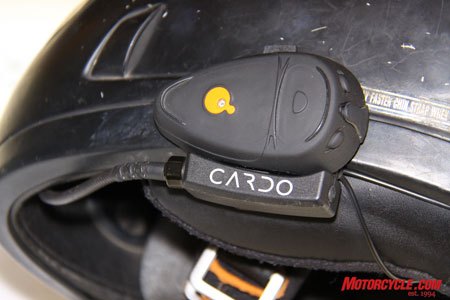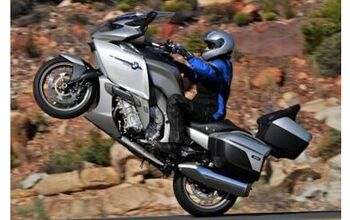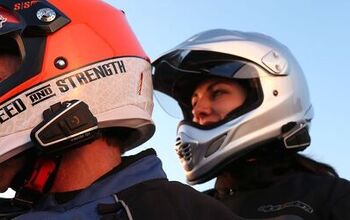Cardo Scala Rider Q2 Bluetooth Communicator Review
How many times have you been the rider in the back of the pack and the only one that knows where the group is going? I also find myself saying “I told you so” quite often, and I enjoy it. What I don’t enjoy is the time lost to confused or lost members of the group. I want to enjoy the trip, not spend it worrying about gassed-out bikes or whether or not we’re going the right direction.
Sometimes you just need to decide, as a group, where to stop for a 10-100 or a crunchy bean & cheese burrito. It’s amazing how enjoyable a group ride can be when you’re all on the same page! And with a plethora of communication options at our disposal, it’s hard to make the right choice.
Many are familiar with the terrific-yet-spendy radio-based Chatterbox communication system. It’s a terrific long-range and expandable solution if you and your friends have the cash to buy into the kit which can run upward of $700 for a pair of high-end units. Lesser expensive solutions for rider-to-passenger and bike-to-bike communication have cropped up in the last few years based on the popular Bluetooth technology.
Enter the function-packed Cardo Scala Rider Q2 system (MSRP $219.99). You might be familiar with the Cardo name from inner-office comm devices or cellular phone accessories such as hands-free headsets. This is basically the same type of cell-phone product, but redesigned to fit into a motorcyclist’s helmet; either full-face or open.
Cardo Systems is a big player in headsets for mobile phones, and the Scala line represents Cardo’s Bluetooth telephone products. The Rider series is its motorcycle-specific product, and the Q2 refers to the latest version of the product which now includes the Bluetooth 2.0 range connectivity.
The small and unobtrusive fully weather-protected unit mounts to your helmet – with a choice of three mounts – and can be installed in minutes. Each of the two speakers and the microphone are hard-wired to the device’s helmet clamp which mounts outside your helmet shell. The communications unit then snaps into the clamp. The communicator pops off easily (but securely) so that it can be hidden from potential thieves. Additional helmet clamps can be had for $30, sparing you the hassle of rewiring the kit when choosing between multiple helmets.
As is standard practice with any Bluetooth device you intend to communicate with, each unit needs to be “paired” to another before you can start correcting the lead rider, I mean, conversing with a fellow riders’ Q2. A simple task even EIC Kevin Duke managed to do with aid of the manual and a few minutes time.
The Q2 system is capable of pairing to up to three devices, which will “speak” to you in singular priority. Pair up your cell phone, GPS navigation device as well as a passenger or fellow rider, and incoming transmissions will clearly connect and never overlap, each making way for the other in accordance to the Bluetooth priorities stack built into the brains of the Q2 unit.
| What's Bluetooth? |
Bluetooth is a transfer protocol originally built as a short-range communications technology intended to replace cables for local exchange of data and information between one person or computer to another. It is a lightweight, robust yet low- power-hungry means of connectivity; perfect for mobile communication. With the latest bandwidth expansion of Bluetooth technology in 2007, the effective range has grown from just a few meters to a few hundred meters. This makes Bluetooth a viable tool for communication between travelers within relatively close proximity to each other. |
Not only can you clearly hold conference calls at 50 miles per hour, the Q2 allows you to tune out the world and tune into your favorite radio station with its built-in FM receiver. Jamming out to the Strokes while riding your local twisted roads is sure to keep you in the zone longer. When incoming phone calls or communiqué from your pals come in, the FM radio automatically mutes and returns after transmission. Very slick, and all without taking you’re hands off the bars!
Cardo’s AGC Technology automatically adjusts the volume of the unit according to wind noise so you don’t blow out your eardrum when you stop at the traffic light after a raucous jam. It’s subtle but somehow works very nicely.
Cardo boasts a 1,640-foot range under ideal circumstances. That may be true in Nebraska, but not in the hills of Malibu. Still, the range of the communicators was often impressive when the two units were in sight of each other. They effectively keep two riders in full duplex contact (talk and listen simultaneously) with each other during both city and highway travel. In addition to connecting two riders, the Q2s will also connect a rider and passenger.
Cardo claims the rechargeable unit has the capacity of eight hours of talk time and one full week of standby charge. We rode from L.A. to Laguna with these units, listening to both the radio and each other singing to ourselves without wearing them out on the full day of riding.
If you and your riding buddy want to save a few bucks, you have the option of ordering a two-pack system called the Rider Q2 Multiset. Its $395.99 MSRP includes factory pairing as well as MP3 player input ability not found on our singular units.
One of our few gripes about this inexpensive and robust device is the amount of pressure necessary to change radio stations. My finger got sore scouring the radio frequencies when trying to find my favorite tunes. It should also be noted that continual Bluetooth connectivity to a cell phone will drain the phone's battery quicker.
After using the Scala Rider Q2s for a few months, we appreciated being able to share thoughts and important info without resorting to pantomime arm gestures.
“In purely pragmatic terms, the Q2s can be invaluable,” says Duke. “Warnings for gravel in a corner or a hidden cop can be shared in an instant. Plus, being able to share random thoughts during a road trip can make the journey more enjoyable.”
Not only that, but understanding each other without screaming into the chin bar of our helmets over road and wind noise is priceless.
Visit http://www.cardowireless.com/ for more information.
More by User






























Comments
Join the conversation